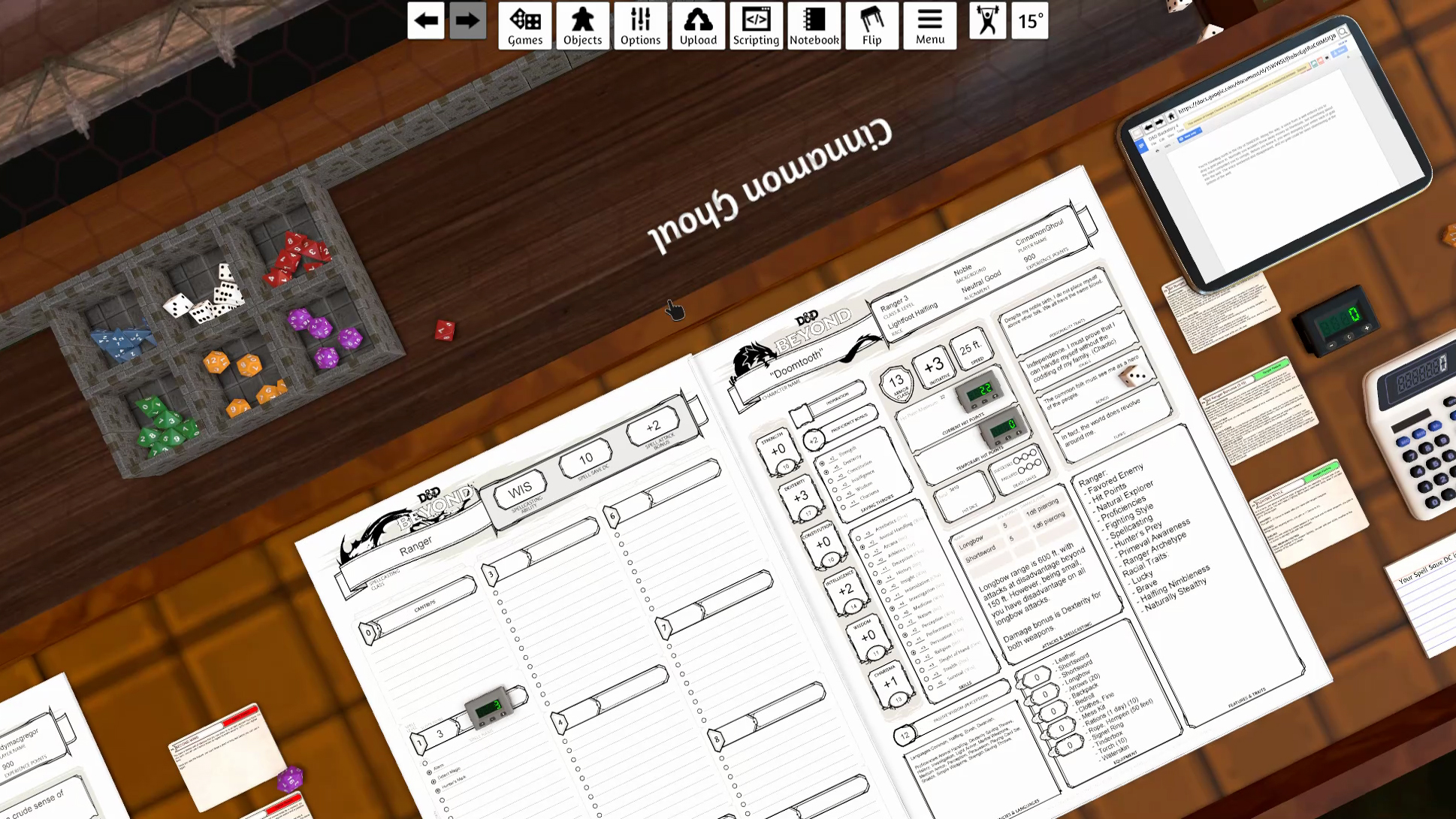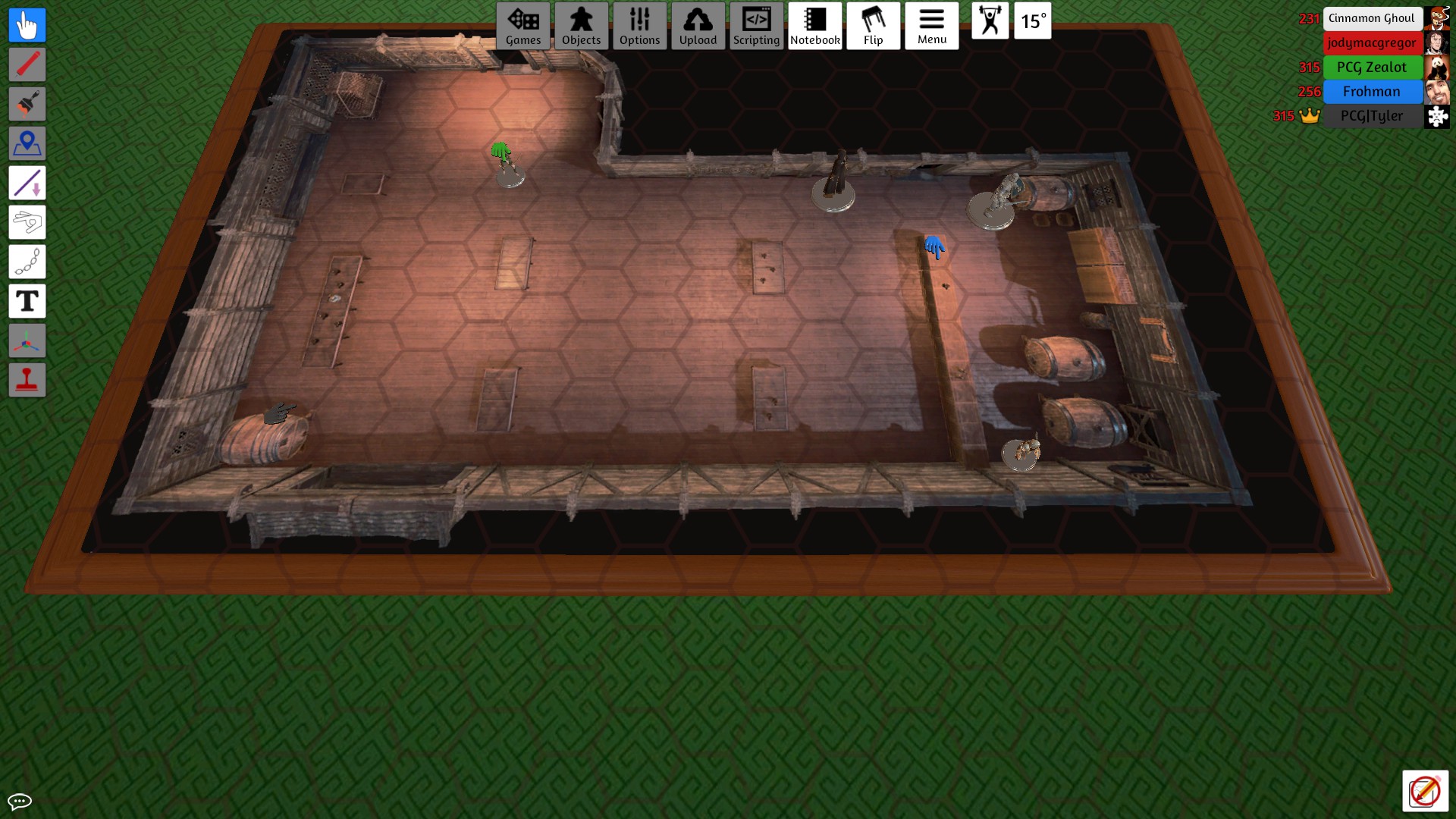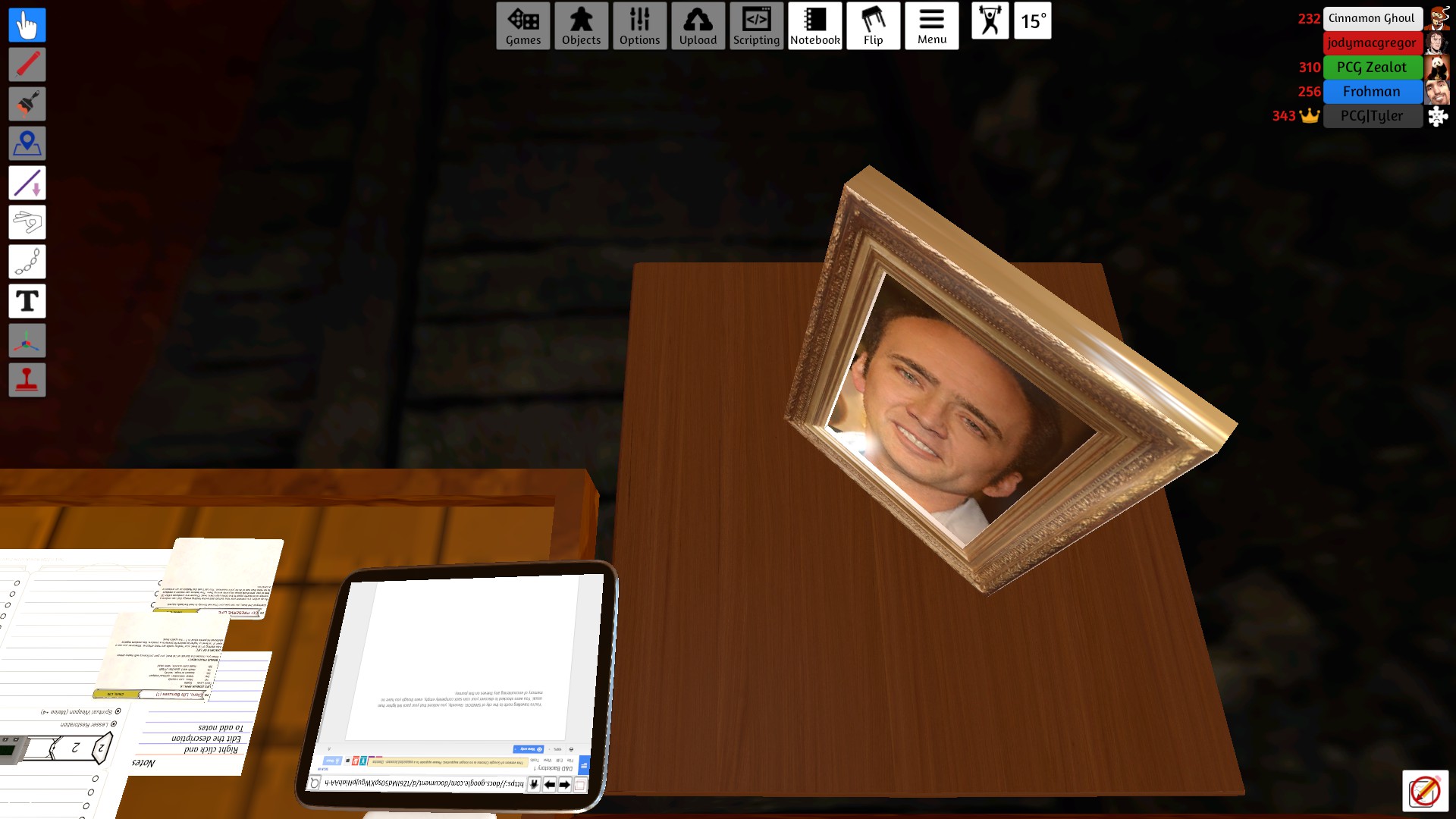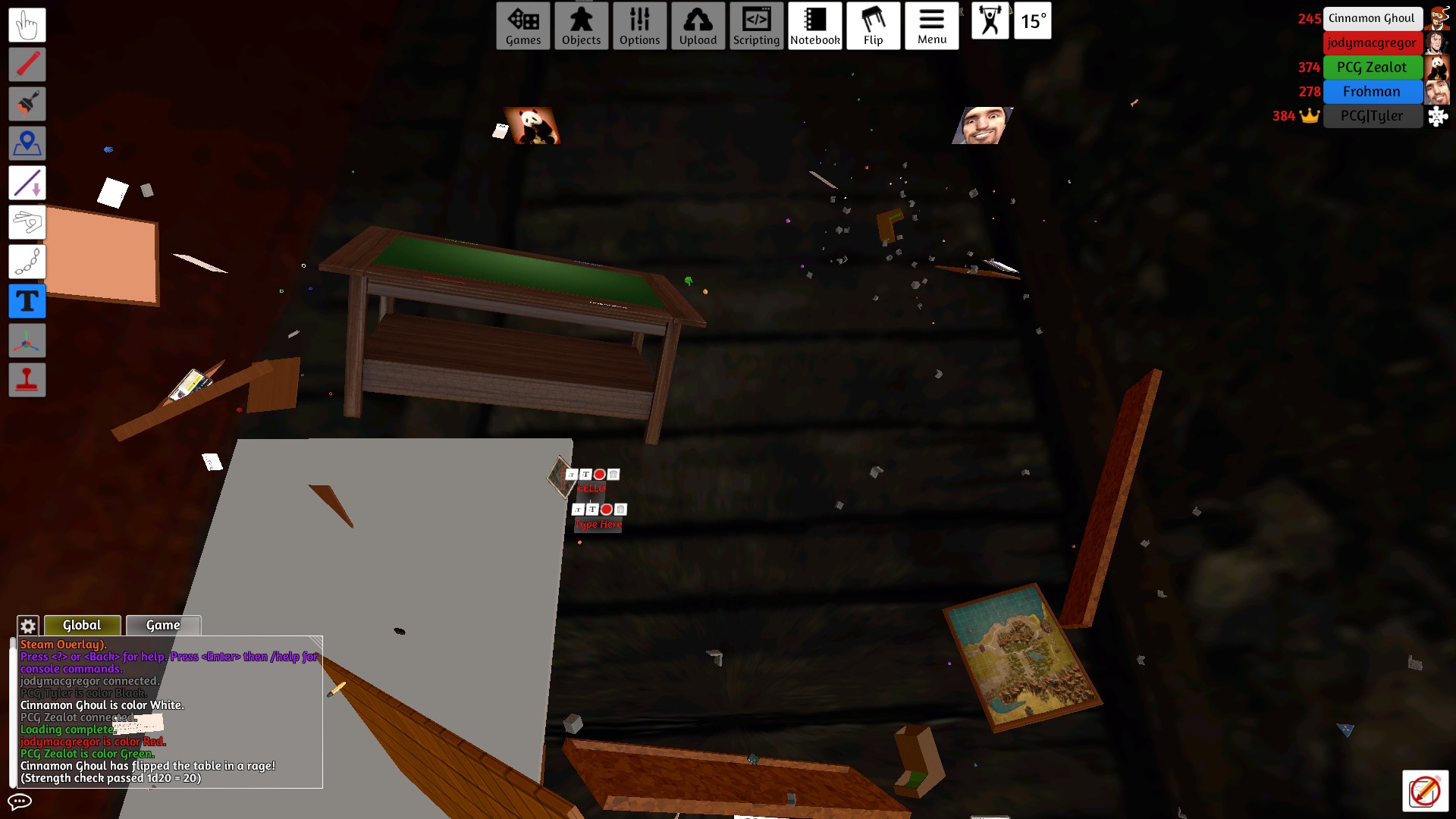We played D&D in Tabletop Simulator and it worked surprisingly well
It's complicated, but viable for pen-and-paper roleplaying.

D&D and other tabletop games are best played sprawled across a dining room table, but I wondered how close we could get to that in-person roleplaying experience without spending 10 grand flying PC Gamer's remote staff to my house. I didn't want to just find the most efficient way to play D&D online (see our guide to services like Roll20.net and Fantasy Grounds for that), but to really emulate a tabletop session. So I gathered a few PC Gamer editors from around the US, Canada, and Australia for a little experiment: D&D 5e in Tabletop Simulator. And it worked! Surprisingly well, even.
Tabletop Simulator is just what it sounds like, a virtual table where game boards, playing cards, dice, figurines, and other objects can be picked up, dealt, rolled, and chucked around. There are built-in rulesets for common games, but everything down to the lighting and individual object physics can be customized. It's powerful—and frustratingly janky, which is why I worried the whole thing might be a bust. If you instinctively hit Ctrl-Z to undo a line you drew, for example, the whole table reloads, and dropping items near boxes sucks them in nearly instantaneously, making all containers dangerous black holes. My players also had atrocious pings, especially our poor indie editor, Jody, who was connecting to me from Australia.
Players will never have to go searching for a D12, because you can copy and paste 50 of them into a pile if you want.
Yet despite a couple disconnects, the session went at about the pace of any in-person D&D session I've played. Tabletop Simulator has some advantages over a real table, too. Players will never have to go searching for a D12, because you can copy and paste 50 of them into a pile if you want. You can quickly upload prepared battle maps, and cover the table with character sheets, DM cheat sheets (which can be hidden from players), and even 'tablets' open to Google Docs or D&D Beyond if you need to look up a spell or monster stats or pass notes to the players.

Our biggest issue didn't have much to do with Tabletop Simulator itself: it was getting over the awkwardness of roleplaying over voice chat. As our heroes began their journey—each of them out of gold, stranded on a dirt road near a remote inn with a storm approaching—they hesitated to speak first to introduce themselves and make a plan. I quickly moved on to a few perception checks followed by a surprise attack to get everyone rolling and making decisions, and after that, the party met a mysterious dwarf and started to loosen up. If we'd gone for a couple more hours, I think the issue may have resolved itself.
Much of the fault for our hesitant start rests on my inexperience as a DM, but the weirdness of the players being disembodied didn't help. In a typical D&D session, they'd be able to make eye contact with the DM before asking questions, or with each other to indicate they're about to speak. We also jumped right into the game without the socializing and feet dragging that typically precedes an in-person game. Next time, I may mix in video chat—it doesn't totally solve the problem, but could help—and make time for chit-chat as I set up the table, so that the players can discuss their characters and get into the right mindset. And rather than the cold open I attempted, I'd have them metagame a little and introduce their characters to each other as players, so that they can more comfortably assume their roles.

The pros and cons of using Tabletop Simulator
Roll20.net is the cheaper, more practical solution for remote D&D.
Roll20.net is the cheaper, more practical solution for remote D&D: a clean mapping interface, easy access to official reference material, built-in video chat, and quick dice rolls. More serious players will probably prefer it, and Tabletop Simulator leaves much to be desired despite its frequent patches. Though the Steam Workshop provides a bounty, I'm surprised by how few high-quality fantasy figurines, backgrounds, and table styles are included by default. Clicking links in the tablets sometimes stops working, and the browser is just about featureless: no tabs, no history, no bookmarks. It's also terrible at handling editable text.
So why use Tabletop Simulator? Primarily, to approximate the feeling of being around a real table, with all the goofing off that goes with it: players ignoring the DM and stacking dice, flicking downed monsters off the table, arguing about whether a dice roll was really a roll. And secondarily, because you love spending hours creatively setting up your play space, which I do.
Keep up to date with the most important stories and the best deals, as picked by the PC Gamer team.

The best thing about Tabletop Simulator is that only the host has to have any Workshop or custom assets used in the game—it's all uploaded to the Steam Cloud and shared with the other players. At the moment, I'm building a multi-layered battle map using hovering boards and a 3D ladder model I imported, and recently, I had some players take on a trio of half-orcs in a game of 'harky,' making them roll d20s to pass and shoot a 'puck' I made by resizing a checkers piece. I'm arguably making it harder for myself by using 3D models and not just a digital pencil, a 2D grid, and a bit of imagination, but the 'physical' space of Tabletop Simulator has only encouraged my creativity, not hampered it. I'm not always going to use maps, but they're useful for keeping track of my more complicated ideas.
As part of the experiment, I also wanted to have as much of my reference material as possible in the game (you can't alt-tab out of a dining room table, and that was the experience I was trying to replicate). So rather than having a physical DM screen cheat sheet awkwardly balanced behind my monitor, or the Monster Manual open in my lap, I put everything I thought I'd need into my Tabletop Simulator setup, including a tablet open to my campaign notes. If you use high-res PNGs as the custom art on in-game 'tiles,' and hold Alt to view them as flat images, or zoom way in, they're perfectly legible. I created PNGs out of four pages pages of the Kobold Press Book of Lairs, and then created custom tiles in Tabletop Simulator for myself to reference.

It worked just fine, though I wouldn't do it exactly the same way again, as it's much easier to just have a browser window open with my notes. A second monitor (or lots of notes on real paper) is definitely the best friend a Tabletop Simulator DM can have, as running it in a small window or alt-tabbing constantly starts to defeat the purpose, barely differentiating it from easier-to-use browser-based solutions.
If the simpler route sounds more appealing to you, do try out Roll20.net, as accounts there are free, while Tabletop Simulator is $20 on Steam. But if you've made your decision and you've got a DM and some willing but geographically-restricted players, below is a quick guide to getting started playing remote D&D in Tabletop Simulator, as well as links to some of the tools I've used.
Starting a game of D&D 5e in Tabletop Simulator
1. Have your players make characters with D&D Beyond's step-by-step character creator. If they don't own the digital Player's Handbook, their options will be restricted as they level up, but it's a good way for newcomers to get started. If they're experienced, they can make their characters manually and send you the details.
2. Both the DM and the players will need to reference the character sheets while playing, and there's lots of ways to make this possible. You can upload a PDF of the sheet to Google Drive, share it publicly for anyone with the link, and then open it in an in-game tablet. You can convert the PDFs to PNGs and create custom 'tiles,' then use Tabletop Simulator's counter tools to keep track of gold pieces, HP, and spell slots. You can transfer the information to these editable character sheets from the Steam Workshop. Or you can just print them out, or open them in another window or monitor.
3. Customize your board in a singleplayer session, making sure to check the option to upload any custom images to the Steam Cloud so that all players will see them (unless they're only for you, the DM). I recommend trying out some pre-made D&D 5e tables from the Steam Workshop and starting there (I used ffrogman's), as the default tables are too small, and many mods already have a hidden DM area set up with tools like a calculator, dice trays, initiative tracker, and note cards. Note that if you click the vertical '...' in the upper right corner of a Workshop mod, you can 'Expand' it to pull the elements you want into your game rather than loading the whole thing.
4. Save your custom table as a 'game' and load it up when you start your multiplayer session. Make sure to password protect your server, as there's apparently been a wave of DDOSing going around. (On that note, I don't recommend trying to play D&D with strangers in a public server. I tried and it went very poorly.) Be sure to save the board state when you're done, so that everything is preserved for the next session. Make lots of backups and save often while you work, too—it is painfully easy to accidentally load a mod instead of expanding it, losing whatever progress you made.
5. Tips for starting your session:
- Give your players a little time to just hang out and chat. It can take a minute to get into the right mindset.
- Consider letting your players introduce their characters out-of-character. It may help break the ice—which is a little harder to break when disembodied—if they're allowed to set expectations about who they're roleplaying as.
- Set clear rules about what constitutes a dice roll (chucking it on the table, right-clicking and selecting 'roll,' placing it in a dice tower). I have players call their roll before they do it, because otherwise I might interpret a die being dropped on the table as a roll.
- If you're using figurines, name your players' figures (either their name, or the name of their character). Otherwise you'll all have to constantly zoom in to figure out who's who.

Useful tools
Dungeon Painter: Not the best interface, but useful for quickly designing maps that you can export as PNGs and import into Tabletop Simulator. I used the Steam version, plus Photoshop, to make some of my maps.
Inkarnate: A fantastic, free way to quickly create a world map—just sign up for the beta. I imported my world map onto a tile, locked it, and then used the Gizmo tool to prop it up in a corner. Drop a token labled 'You Are Here' on it if you want.
Donjon's fantasy generators: Part of being a DM is thinking on your feet, but when your players really catch you off guard, a little creative assistance can be needed. Donjon offers a great selection of random fantasy and D&D generators. I'll probably get a lot of use out of its random inn generator especially.
RPG Tinker's NPC generator: Need to quickly create an NPC for your players to meet, or generate stats for one you didn't think they were going to fight? RPG Tinker can instantly generate stats and attack abilities for an opponent or ally of any challenge rating.

Tyler grew up in Silicon Valley during the '80s and '90s, playing games like Zork and Arkanoid on early PCs. He was later captivated by Myst, SimCity, Civilization, Command & Conquer, all the shooters they call "boomer shooters" now, and PS1 classic Bushido Blade (that's right: he had Bleem!). Tyler joined PC Gamer in 2011, and today he's focused on the site's news coverage. His hobbies include amateur boxing and adding to his 1,200-plus hours in Rocket League.

